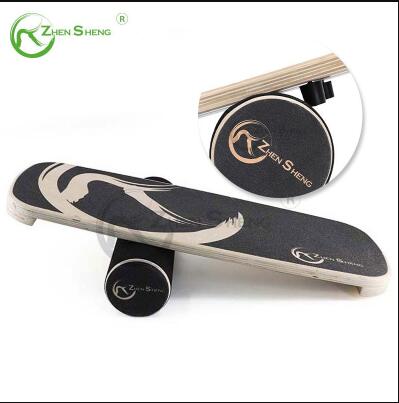Balance is essential to everything we do, whether we're sitting in a chair, running on a treadmill, carrying groceries, or even standing still. Everything depends on our ability to stay upright and centered - but balance isn't always easy.
"It's a natural category of movement that [many people] are missing," says Galina Denzel, a restorative movement specialist and personal trainer who specializes in chronic pain and trauma. She notes that our increasingly sedentary lifestyles are taking us away from the environments in which we would naturally develop better balance.
But balance tools such as stability balls, BOSU balance trainers and, yes, balance boards can be used as supplements, she says, to create the variability and instability our bodies need to cope with in order to improve our balance.

What is a balance board?
A balance board is a counterbalance board. It usually has a flat, hard, even surface at the top with a soft or rounded, unstable bottom (the bottom may or may not be attached to the actual board section). Balance boards are usually made of plastic or wood. They are used not only in athletic environments, but also for physical therapy and rehabilitation.
The user stands on a flat surface and struggles to create or maintain balance. When you use a balance board, you may end up looking a bit like a surfer on dry land as you stand on the board and extend your arms to help keep you centered.
Benefits of using a balance board
Almost anyone can find a way to challenge themselves on a balance board. Overall, according to Denzel, the equipment helps develop:
Balance and coordination
Motor skills and reaction time
Strength and stability to help prevent injuries
Core strength to help you maintain movement at any age
However, there are deeper benefits to exercising with a balance board, says Denzel, co-author of Eat Well, Move Well, Live Well. For beginners, balance exercises (like you do on a balance board) are a great addition to a core-strengthening program because your abdominal muscles allow you to stay upright.
"Think of balance as an integral part of a comprehensive exercise program that may include flexibility, mobility, strength and endurance training," she says. That's why athletes - including skiers, surfers, dancers and tennis players - train on balance boards. These exercises also improve everyday functional movements - the bending, stretching and turning movements that often serve us well.
Denzel even points to a 2017 study published in Scientific Reports that found improvements in memory and spatial cognition in participants who took part in balance training. "Interestingly, I've seen a decrease in anxiety and fear of exercise," she says.
Balance board exercises
Trying something as simple as holding still on a balance board can be a big help for stability, coordination and spatial awareness. But Denzel shares with her clients some additional balance board exercises that pose a greater challenge to them.
If any of these exercises are too easy for you, try them with your eyes closed. But make sure you first really master all of the following balance board exercises and try them with your eyes closed when you have a spotter, especially on your first attempt.
Move 1: Simple Starting Position
This challenges the visual and proprioceptive systems (spatial awareness).
Stand with your feet hip distance apart and your feet pointing straight ahead. Hold yourself steady and maintain proper posture.
Once you can balance and stand still, rotate your head from side to side and move your eyes to look up, down, left and right.
Movement 2: Mini Squat
You may not be able to squat as low as you would on solid ground, but this exercise will really work your lower body and core strength.
Place your feet slightly wider apart than hip distance and practice squatting without losing your balance.
Slowly bend your knees and drop into your hips, then stand up.
Movement 3: Play catch
From standing with your feet hip-distance apart and pointing forward, throw a ball to a partner with one or both hands.
Don't have a partner? Throw the ball back and forth to yourself, either bouncing off the wall or in the air from one hand to the other.
Movement 4: Kneeling Spin
Place your hands on your hips and kneel on the board.
While focusing on your abdominal muscles, begin to slowly rotate your body.
Once you have successfully completed a few rotations, slow down and then reverse so that you are rotating in the opposite direction.
Move 5: Left and Right Tapping
Complete this slightly more advanced balance board exercise.
Stand on the board with your bare feet.
Slowly tilt back and forth, side to side, to maintain balance so that one side of the board touches the ground.
Repeat this for 60 seconds.
Read more: 11 BOSU Ball Exercises on the Balance Trainer
How to use a standing tabletop balance board
If you use a standing desk at work, you can increase the physical benefits by adding a balance board to your workday. To get the most out of your balance board at work and to ensure your safety, Denzel recommends.
Wear flat shoes so that your toes and heels are flush with the board, distribute your weight evenly across your heels stacking your pelvis, torso and neck vertically to find a stable center of gravity on the board, once you are stable introduce micro movements that are not too distracting such as shifting your balance from one leg to the other, take a break to stand stable on the floor so you are not on the balance board all day.
Previous: What is a Lever Belt and How Do I Wear It?
Next: 8 Power Rack Exercises You Should Start Doing Today! 2
Copyright:@2020-2021
Comments Please sign in or sign up to post.
0
0 of 500 characters used